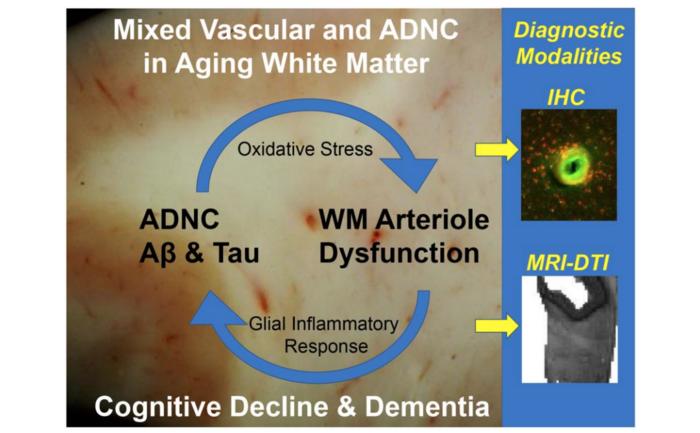“The molecular mechanisms that mediate enhanced dysfunction of white matter parenchymal arterioles when vascular dysfunction and ADNC coincide remain elusive.”

Credit: 2023 Bagi et al.
“The molecular mechanisms that mediate enhanced dysfunction of white matter parenchymal arterioles when vascular dysfunction and ADNC coincide remain elusive.”
BUFFALO, NY- September 12, 2023 – A new editorial paper was published in Aging (listed by MEDLINE/PubMed as “Aging (Albany NY)” and “Aging-US” by Web of Science) Volume 15, Issue 16, entitled, “Microvascular contributions to white matter injury in Alzheimer’s disease.”
In their new editorial, researchers Zsolt Bagi, Larry S. Sherman and Stephen A. Back from Augusta University discuss mechanisms of cognitive impairment and dementia. Impairments in cognitive and executive function of presumed cerebral microvascular origin are important and recently recognized neuropathological manifestations of vascular contributions to cognitive impairment and dementia (VCID). It has been long known that hypertensive cerebrovascular disease also involves a spectrum of subcortical small vessel diseases, such as arteriolosclerosis and lipohyalinosis of small penetrating arterioles, which contribute to progressive injury of periventricular, frontal and parietal white matter (WM).
“However, until recently, recognition of the role of WM injury during aging and the progression of Alzheimer’s disease and related dementias (AD/ADRD) was very limited.”
Despite growing interest in VCID and AD/ADRD, there have been few studies of mechanistic links between subcortical small vessel disease, WM injury and cognitive decline. Even though WM constitutes >80% of the human cerebral hemispheres, a PubMed search of AD and WM injury yielded only 381 articles (including reviews) vs. 193,303 articles for AD alone. Notably, 50% of diagnosed AD patients have mixed vascular and AD pathology. Hence, there is a critical need to explore connections between AD, WM injury and cerebral small vessel disease to define mechanisms and diagnostic features of mixed vascular and AD neuropathological change (ADNC).
“To provide rigorous access to human WM lesions, we recently developed a unique rapid autopsy brain procurement protocol using specimens donated by participants in the Adult Changes in Thought (ACT) study, a prospective, population-based study of aging and incident dementia among men and women in Seattle, Washington [5].”
Read the full editorial: DOI: https://doi.org/10.18632/aging.204997
Corresponding Author: Zsolt Bagi
Corresponding Email: [email protected]
Keywords: cerebrovascular, neuropathology, vasodilation, parenchymal, arteriole
Sign up for free Altmetric alerts about this article: https://aging.altmetric.com/details/email_updates?id=10.18632%2Faging.https://doi.org/10.18632/aging.204997
About Aging:
Launched in 2009, Aging publishes papers of general interest and biological significance in all fields of aging research and age-related diseases, including cancer—and now, with a special focus on COVID-19 vulnerability as an age-dependent syndrome. Topics in Aging go beyond traditional gerontology, including, but not limited to, cellular and molecular biology, human age-related diseases, pathology in model organisms, signal transduction pathways (e.g., p53, sirtuins, and PI-3K/AKT/mTOR, among others), and approaches to modulating these signaling pathways.
Please visit our website at www.Aging-US.com and connect with us:
- SoundCloud
- YouTube
- LabTube
Click here to subscribe to Aging publication updates.
For media inquiries, please contact [email protected].
Aging (Aging-US) Journal Office
6666 E. Quaker Str., Suite 1B
Orchard Park, NY 14127
Phone: 1-800-922-0957, option 1
###
Journal
Aging-US
DOI
10.18632/aging.204997
Method of Research
Commentary/editorial
Subject of Research
People
Article Title
Microvascular contributions to white matter injury in Alzheimer’s disease
Article Publication Date
21-Aug-2023




